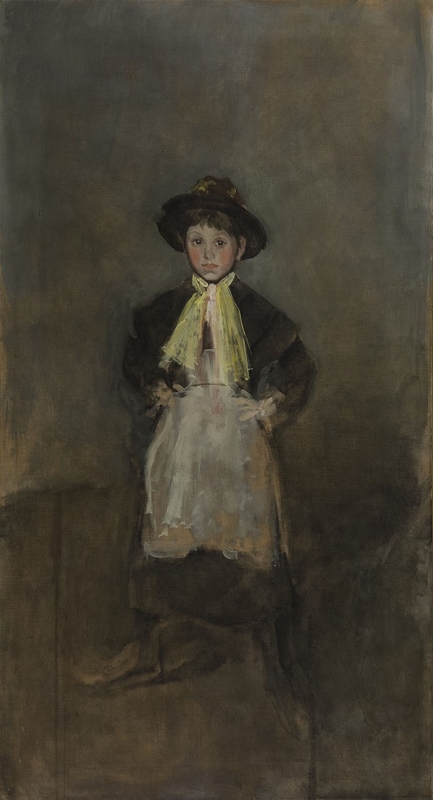Titles
One main title has been suggested:
- 'The Chelsea Girl' (1893, World's Columbian Exposition, Chicago). 1
- 'The Chelsea Girl' (1893, Sixty-third Annual Exhibition, Philadelphia). 2
- 'The Chelsea Girl' (1980, YMSM). 3
Description
A full-length portrait of a girl, in vertical format. She stands with legs apart and hands on hips, facing the viewer. She wears a brown hat with a fairly high crown and comparatively broad brim, over dark brown hair cut short in a fringe. She wears a dark grey three-quarter length dress or coat with a very broad dark brown collar, and over this, a white apron, and cream scarf tied at her neck. She seems to be wearing gloves but this is not clear. The background is beige shading to a darker brown. Some vertical lines to left and right of the figure, and pentimenti, suggest the figure may have been painted over an earlier composition.
Sitter
The sitter was 'a coster child', according to Walter Richard Sickert (1860-1942). 4 A costermonger, coster, or costard was a street seller, mainly of fruit and vegetables, selling from a tray or barrow. Mayhew reckons there were 30,000 such street sellers in London, and discusses their children at some length, for example, under the heading 'OF THE EDUCATION OF COSTERMONGERS' CHILDREN' :
'I have used the heading of "Education," but perhaps to say "non-education," would be more suitable. Very few indeed of the costermongers' children are sent even to the Ragged Schools; and ... it is done more that the mother may be saved the trouble of tending them at home, than from any desire that the children shall acquire useful knowledge. Both boys and girls are sent out by their parents in the evening to sell nuts, oranges, &c., at the doors of the theatres, or in any public place, or "round the houses" (a stated circuit from their place of abode). This trade they pursue eagerly for the sake of "bunts," though some carry home the money they take, very honestly. The costermongers are kind to their children, "perhaps in a rough way, and the women make regular pets of them very often." One experienced man told me, that he had seen a poor costermonger's wife – one of the few who could read – instructing her children in reading; but such instances were very rare. The education of these children is such only as the streets afford; and the streets teach them, for the most part … a precocious acuteness – in all that concerns their immediate wants, business, or gratifications; a patient endurance of cold and hunger; a desire to obtain money without working for it; a craving for the excitement of gambling; an inordinate love of amusement; and an irrepressible repugnance to any settled in-door industry. ' 5
Notes:
1: World's Columbian Exposition, Department of Fine Arts, Chicago, 1893 (cat. no. 744).
2: Sixty-third Annual Exhibition, Pennsylvania Academy of the Fine Arts, Philadelphia, 1893 (cat. no. 26).
3: YMSM 1980 [more] (cat. no. 314).
5: Mayhew, Henry, London Labour and the London Poor, 1851, 1861-1862, Victorian London website at http://www.victorianlondon.org.
Last updated: 4th June 2021 by Margaret






